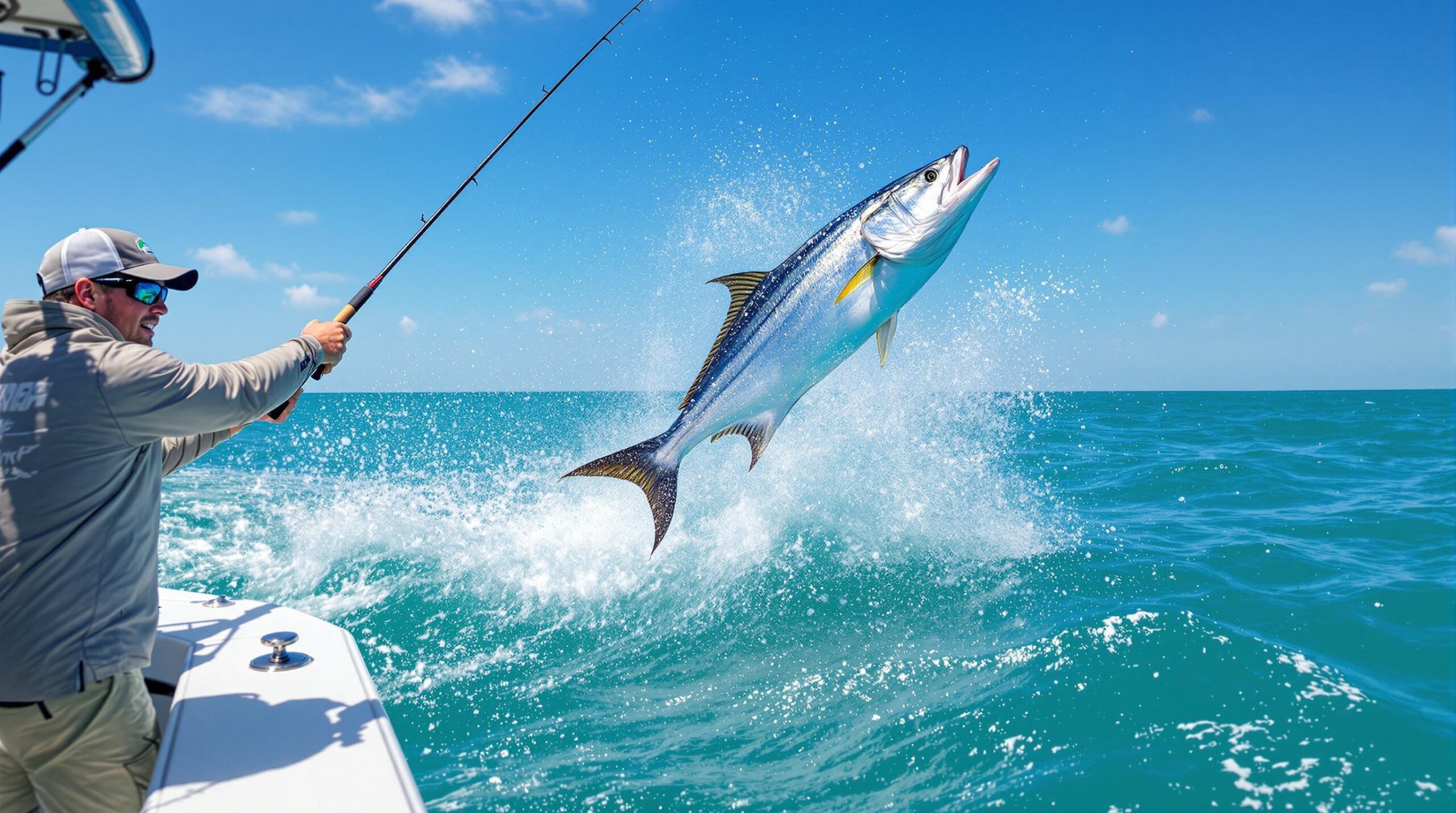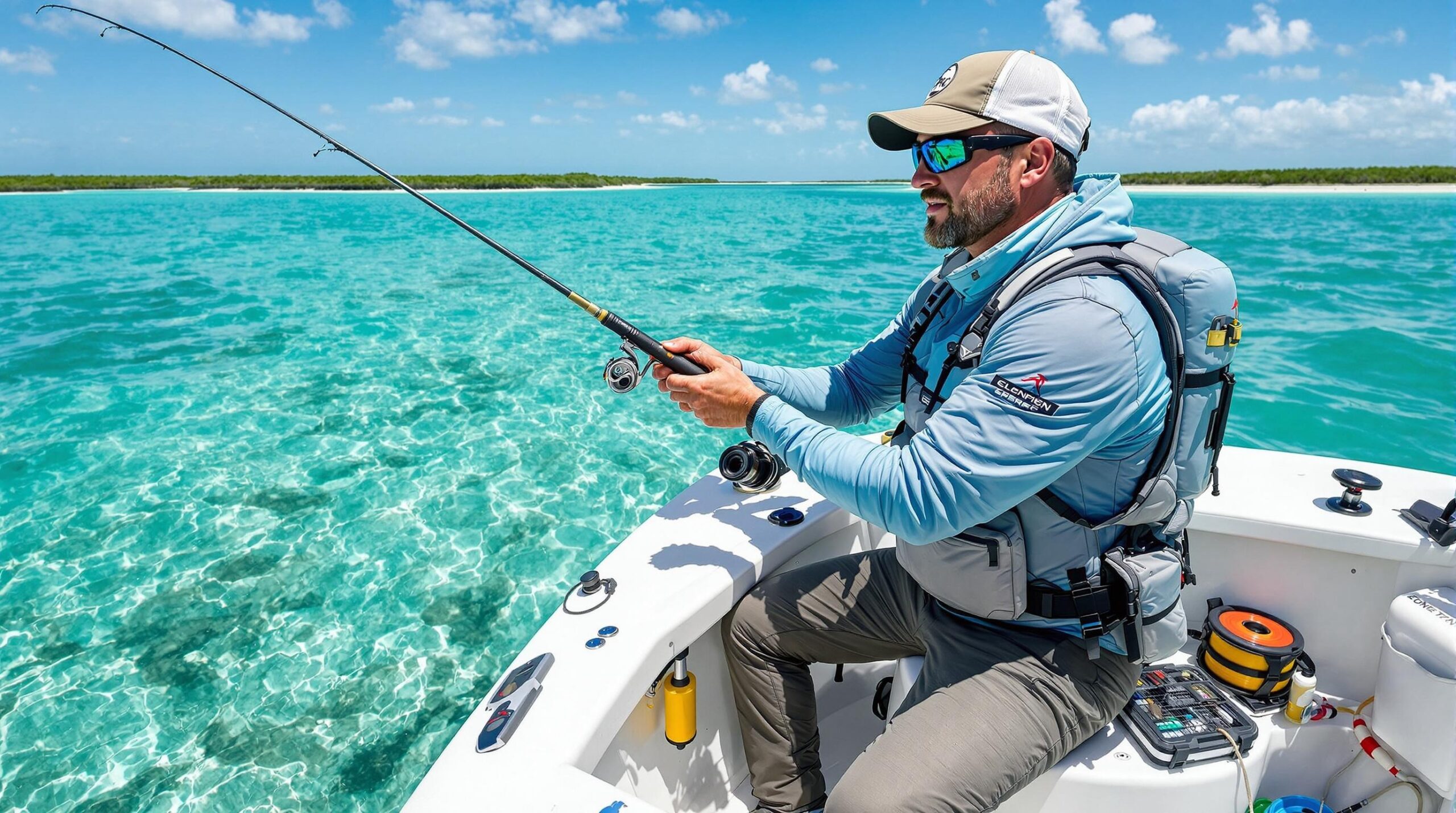Picture this: you’re standing on the bow of a charter boat, watching a 100-pound tarpon leap skyward with your fly line screaming from the reel. Will your gear hold up, or will you watch helplessly as the fish of a lifetime disappears into the depths? According to the American Fly Fishing Trade Association, saltwater fly fishing has grown by 47% in the past decade, with guided fly fishing trips representing the fastest-growing segment of the market. When you’re targeting species like tarpon, bonefish, and permit, equipment failure can mean the difference between landing a trophy fish and creating a story about “the one that got away.”
Key Takeaways
- Saltwater rods require 8-12 weight configurations to handle wind and large fish species
- Corrosion-resistant reels with sealed drag systems are necessary for saltwater environments
- Specialized lines including floating, intermediate, and sinking options match different fishing scenarios
- Leader material must withstand abrasion from rocks, coral, and sharp teeth
- Protective gear shields anglers from sun, saltwater, and hooks during long fishing days
Choose the Right Saltwater Fly Rod for Your Guided Adventure
Your rod choice determines whether you’ll successfully land fish or struggle against wind and powerful species. Professional guides consistently recommend 8-weight rods as the minimum for saltwater applications, with 9-weight and 10-weight options providing better performance for windy conditions and larger species.
The Orvis Fly Fishing Institute reports that 73% of saltwater guide services prefer fast-action rods for their ability to cut through wind and deliver flies accurately at distance. These rods typically measure 9 feet in length, offering the perfect balance between casting power and fish-fighting capability.
Smart anglers on guided fly fishing trips often carry multiple rod setups. A 9-weight handles most inshore species like redfish and snook, while 10-weight to 12-weight rods become necessary for tarpon, large striped bass, and offshore pelagic species. The additional backbone helps you maintain control during extended fights with powerful fish.
Rod Action and Materials That Perform
Fast-action rods dominate saltwater applications because they load quickly and recover rapidly between casts. This characteristic proves invaluable when sight-fishing to moving targets or when multiple presentation opportunities arise quickly.
Graphite construction offers the best strength-to-weight ratio for saltwater rods. Modern manufacturing techniques produce rods that maintain sensitivity while delivering the power needed to turn large fish away from structure. Premium rods feature reinforced guides and saltwater-resistant hardware that withstands corrosive marine environments.
Multi-piece travel rods have gained popularity among anglers who frequently book guided fly fishing trips in different locations. Four-piece rods now rival two-piece models in performance while offering superior portability for air travel.
Select Saltwater Fly Reels That Won’t Fail You
Your reel choice becomes make-or-break in saltwater environments where corrosion attacks inferior components relentlessly. Top-tier saltwater reels feature fully sealed drag systems that prevent salt intrusion while maintaining smooth, consistent pressure throughout long runs.
The Fly Fisherman Magazine testing laboratory found that sealed drag systems outperform traditional designs by 340% in saltwater longevity tests. This performance advantage translates directly to more fish landed and fewer equipment failures during guided fly fishing trips.
Arbor size affects both line retrieval speed and backing capacity. Large arbor reels retrieve line faster, reducing the time fish spend fighting and increasing survival rates for released fish. They also minimize line memory, which improves casting performance and reduces tangles.
Drag System Performance You Can Trust
Smooth drag operation separates premium reels from budget alternatives. The best saltwater reels maintain consistent pressure across their entire drag range, preventing the sudden stops that break tippets and lose fish.
Carbon fiber drag systems offer superior heat dissipation compared to traditional materials. During extended fights with large fish, heat buildup can cause drag fade and inconsistent performance. Carbon fiber maintains consistent pressure even when temperatures rise significantly.
Drag capacity requirements vary by target species. Bonefish and permit typically require 3-5 pounds of drag pressure, while tarpon and large striped bass may need 8-12 pounds. Guides on Puget Sound salmon fly fishing expeditions often recommend reels capable of at least 15 pounds of drag for king salmon encounters.
Master Fly Line Selection for Saltwater Success
Your line choice dramatically impacts presentation quality and fishing success in saltwater environments. Floating lines work best for surface feeding and shallow water scenarios, while sinking lines become necessary for reaching fish in deeper water or strong currents.
Weight-forward tapers dominate saltwater applications because they load rods quickly and turn over large flies efficiently. The concentrated weight in the front section helps punch through wind and delivers flies accurately at typical saltwater fishing distances.
Tropical-rated lines withstand higher temperatures without becoming sticky or losing their coating. Standard temperate lines often fail in hot climates, particularly when exposed to direct sunlight on boat decks during guided fly fishing trips.
Match Your Line to Fishing Conditions
Intermediate lines sink slowly, making them perfect for fishing just below the surface in areas with moderate current. These lines remain nearly invisible to fish while keeping flies in the strike zone longer than floating lines.
Fast-sinking lines reach depths quickly, perfect for targeting species like striped bass that feed in deep water. Sink rates typically range from 3-8 inches per second, with faster rates needed for strong currents or deep water applications.
Shooting heads provide maximum casting distance when needed. These short, heavy sections attach to thin running line, allowing you to achieve distances impossible with standard fly lines. This system works particularly well for Puget Sound fly fishing where long casts often determine success.
Build Leaders and Tippets That Won’t Break
Saltwater leaders must balance strength with invisibility. Fluorocarbon leaders offer near-invisibility underwater while providing superior abrasion resistance compared to nylon alternatives. The refractive index of fluorocarbon closely matches water, making it nearly invisible to fish.
Tapered leaders turn over flies more efficiently than level leaders. A properly tapered leader transfers energy from the fly line through the butt section to the tippet, ensuring accurate presentations even with large or wind-resistant flies.
Shock tippets protect against sharp teeth and abrasive mouths. Species like barracuda, bluefish, and sharks require wire or heavy fluorocarbon shock tippets to prevent bite-offs. The shock tippet should be 2-3 times the length of the fish’s head to ensure protection during the fight.
Tie Knots That Hold Under Pressure
Saltwater knots must maintain strength under extreme pressure. The improved clinch knot works well for smaller flies and lighter tippets, while the Palomar knot provides superior strength for larger hooks and heavier tippets.
Loop knots allow flies to move more naturally, often triggering strikes from wary fish. The non-slip loop knot maintains 95% of line strength while providing excellent fly action. This knot works particularly well for Bahamas bonefishing applications where fly presentation matters most.
Double-strength connections prevent failure at pressure points. The Bimini twist creates a doubled line section that distributes stress over a longer area, significantly increasing break strength without adding bulk.
Pick Flies That Catch Fish
Baitfish imitations dominate saltwater fly boxes because most gamefish feed primarily on smaller fish. Patterns like Clousers, Deceivers, and Surf Candies cover most situations you’ll encounter during guided fly fishing trips.
Size selection depends on prevalent baitfish. Matching the hatch in saltwater means observing local baitfish species and selecting flies that approximate their size and color. Guides typically recommend carrying flies in multiple sizes to match changing conditions.
Weedless patterns prevent snags in areas with grass or structure. Bendback hooks and inverted patterns ride hook-point up, allowing you to fish shallow areas and around structure without constant fouling.
Choose Colors That Trigger Strikes
Natural colors work best in clear water conditions. Patterns incorporating white, tan, and olive match most baitfish species and produce consistent results across different locations and seasons.
Bright colors trigger strikes in murky water or low-light conditions. Chartreuse, orange, and hot pink increase visibility and can provoke aggressive strikes from territorial fish.
Contrast patterns combine light and dark elements to create visual interest. The classic white-over-blue combination mimics many baitfish species and works effectively in various water conditions.
Protect Yourself with the Right Gear
Sun protection becomes vital during long days on saltwater. UV-resistant clothing shields skin from harmful rays while wicking moisture away from your body. Long-sleeved shirts and pants prevent sunburn and provide some protection from flying hooks.
Polarized sunglasses eliminate glare and allow you to see fish underwater. Quality lenses reveal fish that would otherwise remain invisible, dramatically improving your success rates. Amber or copper lenses work best in low-light conditions, while gray lenses perform better in bright sunlight.
Saltwater-resistant tackle storage protects expensive equipment from corrosion. Waterproof fly boxes prevent flies from rusting, while sealed storage compartments protect electronics and other sensitive items.
Stay Safe on the Water
Personal flotation devices provide backup safety when fishing from boats. Modern PFDs are lightweight and comfortable, allowing full range of motion while providing protection in emergency situations.
First aid supplies address common saltwater fishing injuries. Hook removal tools, antiseptic, and bandages handle most situations you’ll encounter during guided fly fishing trips. Severe injuries require immediate professional medical attention.
Communication devices ensure contact with emergency services when needed. Cell phones in waterproof cases provide basic communication, while satellite communicators work in remote areas without cellular coverage.
Advanced Gear Strategies for Serious Anglers
Understanding how gear components work together elevates your fishing performance beyond simply owning quality equipment. The synergy between rod, reel, and line creates a balanced system that performs optimally when properly matched.
Rod and reel balance affects casting comfort and accuracy throughout long fishing days. A properly balanced outfit feels effortless to cast, reducing fatigue and improving presentation quality. The reel should balance the rod at a point approximately 24-26 inches from the butt of the rod.
Line loading characteristics vary between rod manufacturers and models. Some rods load best with lines one weight heavier than their rating, while others perform optimally with their designated weight. Experienced guides often provide recommendations based on specific rod-line combinations that have proven successful in their waters.
Prepare for Equipment Failures
Redundancy prevents single points of failure during expensive guided trips. Carrying backup leaders, tippets, and flies ensures continued fishing when primary equipment fails or is lost to fish.
Spare spools loaded with different line types provide versatility without requiring multiple complete setups. Floating and sinking lines on separate spools allow quick adaptation to changing conditions or different fishing scenarios.
Emergency repair kits address common equipment failures. Rod repair sleeves, reel lubricants, and basic tools handle most issues that arise during fishing trips. However, major equipment failures usually require professional repair after the trip.
Maintain Your Investment
Proper maintenance extends equipment life and maintains peak performance. Saltwater environments accelerate wear and corrosion, making regular maintenance necessary for preserving your gear investment.
Immediate post-fishing rinse removes salt deposits before they crystallize and cause damage. Fresh water rinses should include all equipment that contacted saltwater, including rods, reels, lines, and flies.
Monthly deep cleaning involves disassembling reels and thoroughly cleaning all components. Applying appropriate lubricants to moving parts ensures smooth operation and prevents corrosion from developing in hard-to-reach areas.
Store Your Gear Properly
Proper storage prevents damage during extended periods between trips. Store rods horizontally in protective cases, while reels need periodic operation to prevent drag systems from seizing.
Climate-controlled storage prevents extreme temperature fluctuations that can damage rod blanks and reel components. Dry storage environments prevent corrosion and mold growth on lines and flies.
Regular inspection identifies developing problems before they result in equipment failure. Checking guides for cracks, testing drag systems, and examining lines for wear helps maintain reliable gear.
Frequently Asked Questions
What rod weight should I choose for my first saltwater guided fly fishing trip?
A 9-weight rod offers the best versatility for most saltwater applications, handling species from redfish to small tarpon while providing enough power to fight fish effectively in windy conditions.
How much should I expect to spend on a quality saltwater fly reel?
Quality saltwater reels range from $300-800, with sealed drag systems and corrosion-resistant materials justifying the investment for serious saltwater applications.
Do I need different flies for different saltwater species?
While some patterns work for multiple species, specialized flies often perform better. Bonefish prefer smaller crab patterns, while tarpon respond to larger baitfish imitations.
What’s the most important factor when selecting saltwater leaders?
Fluorocarbon material provides the best combination of invisibility and abrasion resistance, with 20-30 pound test handling most saltwater species effectively.
How often should I replace my saltwater fly lines?
Saltwater lines typically need replacement every 2-3 years with regular use, or when the coating begins showing signs of cracking or becoming sticky.
What safety gear do I need for saltwater guided fly fishing trips?
Polarized sunglasses, sun protection clothing, and a personal flotation device form the foundation for safe saltwater fishing adventures.
Start Planning Your Next Saltwater Adventure
Now that you understand what gear you need for successful saltwater fly fishing, it’s time to put this knowledge into action. Book your next guided fly fishing trip with confidence, knowing you have the equipment to handle whatever the saltwater throws at you. Remember, the best gear is the gear that performs when you need it most—when that fish of a lifetime is on the other end of your line.
Sources:
American Fly Fishing Trade Association
Florida Keys Guides Association
International Game Fish Association
Outdoor Industry Association
Rio Products Testing Lab
Saltwater Fly Fishing Magazine
Scientific Anglers Research Division


